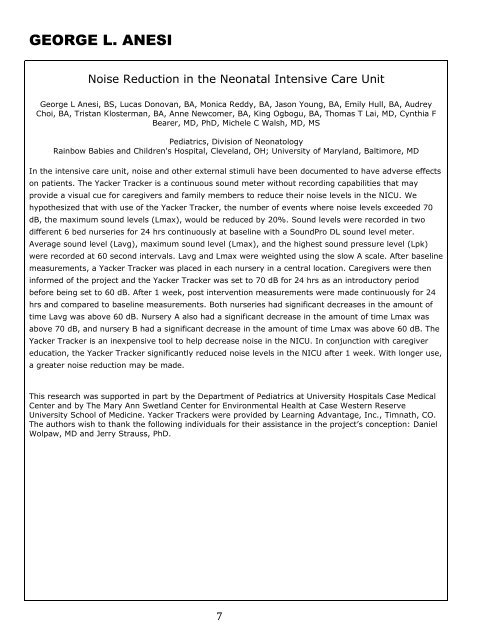student research day - Case Western Reserve University School of ...
student research day - Case Western Reserve University School of ...
student research day - Case Western Reserve University School of ...
Create successful ePaper yourself
Turn your PDF publications into a flip-book with our unique Google optimized e-Paper software.
GEORGE L. ANESI<br />
Noise Reduction in the Neonatal Intensive Care Unit<br />
George L Anesi, BS, Lucas Donovan, BA, Monica Reddy, BA, Jason Young, BA, Emily Hull, BA, Audrey<br />
Choi, BA, Tristan Klosterman, BA, Anne Newcomer, BA, King Ogbogu, BA, Thomas T Lai, MD, Cynthia F<br />
Bearer, MD, PhD, Michele C Walsh, MD, MS<br />
Pediatrics, Division <strong>of</strong> Neonatology<br />
Rainbow Babies and Children's Hospital, Cleveland, OH; <strong>University</strong> <strong>of</strong> Maryland, Baltimore, MD<br />
In the intensive care unit, noise and other external stimuli have been documented to have adverse effects<br />
on patients. The Yacker Tracker is a continuous sound meter without recording capabilities that may<br />
provide a visual cue for caregivers and family members to reduce their noise levels in the NICU. We<br />
hypothesized that with use <strong>of</strong> the Yacker Tracker, the number <strong>of</strong> events where noise levels exceeded 70<br />
dB, the maximum sound levels (Lmax), would be reduced by 20%. Sound levels were recorded in two<br />
different 6 bed nurseries for 24 hrs continuously at baseline with a SoundPro DL sound level meter.<br />
Average sound level (Lavg), maximum sound level (Lmax), and the highest sound pressure level (Lpk)<br />
were recorded at 60 second intervals. Lavg and Lmax were weighted using the slow A scale. After baseline<br />
measurements, a Yacker Tracker was placed in each nursery in a central location. Caregivers were then<br />
informed <strong>of</strong> the project and the Yacker Tracker was set to 70 dB for 24 hrs as an introductory period<br />
before being set to 60 dB. After 1 week, post intervention measurements were made continuously for 24<br />
hrs and compared to baseline measurements. Both nurseries had significant decreases in the amount <strong>of</strong><br />
time Lavg was above 60 dB. Nursery A also had a significant decrease in the amount <strong>of</strong> time Lmax was<br />
above 70 dB, and nursery B had a significant decrease in the amount <strong>of</strong> time Lmax was above 60 dB. The<br />
Yacker Tracker is an inexpensive tool to help decrease noise in the NICU. In conjunction with caregiver<br />
education, the Yacker Tracker significantly reduced noise levels in the NICU after 1 week. With longer use,<br />
a greater noise reduction may be made.<br />
This <strong>research</strong> was supported in part by the Department <strong>of</strong> Pediatrics at <strong>University</strong> Hospitals <strong>Case</strong> Medical<br />
Center and by The Mary Ann Swetland Center for Environmental Health at <strong>Case</strong> <strong>Western</strong> <strong>Reserve</strong><br />
<strong>University</strong> <strong>School</strong> <strong>of</strong> Medicine. Yacker Trackers were provided by Learning Advantage, Inc., Timnath, CO.<br />
The authors wish to thank the following individuals for their assistance in the project’s conception: Daniel<br />
Wolpaw, MD and Jerry Strauss, PhD.<br />
7
















